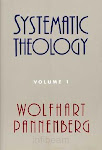1 week ago
Tuesday, 16 December 2008
Bernhard Lohse's History of Doctrine (3 of 3)
“Who do you say that I am?”
A Short History of Christian Doctrine opened with Jesus’ famous question: “Who do you say I am?” (Mt. 16:15). In the final paragraph we return to this question:
“Thus today’s generation in the church, no less than the former generation, is faced with the task of giving through its witness in word and deed an answer to the question which the Lord once directed to the disciples, ‘Who do you say that I am?’ The answer to this question must be given in a new way. But if it proceeds from faith it will be given in unity with the faith and the confession of the fathers.” (p. 246-7.)
The Revised Edition, however, does not end here; as said, the author adds a short account of the Second Vatican Council. This accounts ends with a similar paragraph to the one quoted above. It is, in fact, nearly identical, making the slight alterations ever more visible. The reading experience ends in an approving smile.
“So the task placed before the contemporary generation of the church is not less than that of its predecessors. In word and deed it must give an answer to the question that the Lord at one time put to the disciples: ‘Who then do you say I am?’ The answer to this question must be given in new ways. But when it issues from faith, it must issue from the unity of faith and the confession of the Father.” (p. 249.)
The smile is, however, soon superseded by a thoughtful expression. One question, above all, was left unanswered.
Dogma vs. divine mystery?
It was not, indeed, the responsibility of the book to give an answer to it, although the question itself virtually leaped from the pages. At various points the relationship of dogma and divine mystery was mentioned, but not clarified.
For instance: “[T]he basic decisions of the Trinitarian controversy and the christological definitions of Chalcedon are alike in this, that in neither case was any attempt made to unravel the mystery of God. What was attempted was the reformulation and confession of the inherited faith of Christianity vis à vis the questions which had been raised.” (p. 99, italics added.) And: “[T]he ancient church with its dogmas did not want to plumb the mystery of the divine person”, but “that it meant to confess its faith with reference to certain newly raised problems” (p. 230, italics added).
It may be asked: What is the difference? Where and how does one draw the line between “confessing the faith dogmatically” and “unraveling or plumbing the mystery”? This overarching question can be broken into smaller questions: What is mystery? What does “plumbing” or “unraveling” mystery mean?
The relationship between dogma and mystery is one of the numerous questions that profoundly intrigue me and to which, pray, some light may be added during the new round of theological studies I have enter.
Subscribe to:
Post Comments (Atom)







2 comments:
to comment on your last words: and it's at the centre of Hahn's stuff:D salvationhistory.com:)
no but generally interesting series. I'm reading something at the moment that comes close, Marian kolmet kasvot by Paavo Hiltunen. It's perhaps the best anti-Catholic argument there is in Finnish. It focuses on Mary with points about the papacy and soteriology as well. Now I want to write a book in response on the history and theology of mariology.
I bless the rains down in Africa!
Great, go for it! BTW, what's the latest with your first book? Is it out already? I want to read it!
Good news: Today I found out that we are collegues again...
P.S. We've had blessed rains down in Africa for two days. Very refreshing, thank you.
Post a Comment